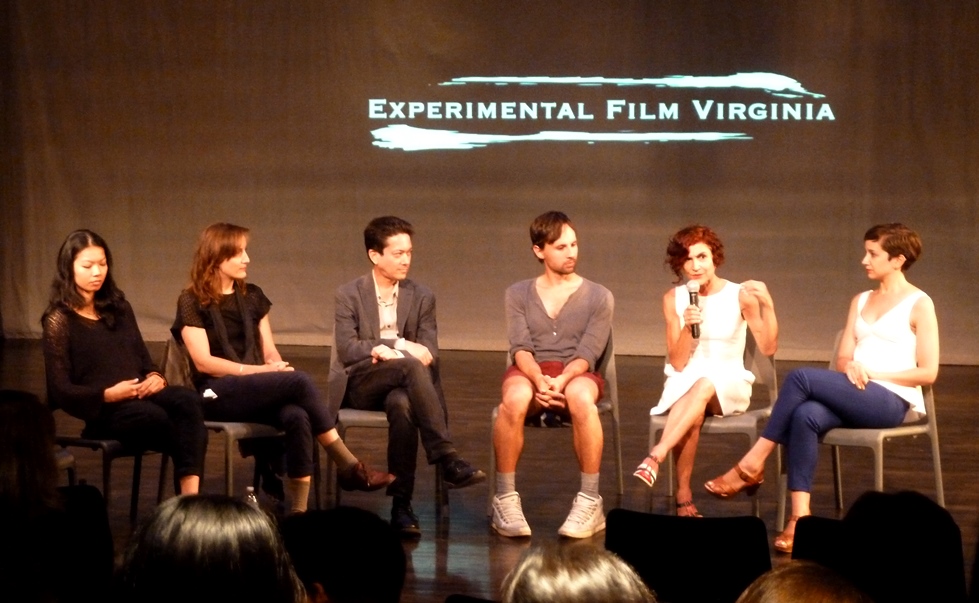By Lynn Chawengwongsa
It can be said that the path of experimental cinema runs parallel to that of commercial cinema, never meeting its mainstream counterpart while simultaneously imparting influences on the visual effects and cinematography of Hollywood films, music videos and television advertisements. Even with the widespread traces of experimental film in media, most people outside the circles of art-house and avant-garde film enthusiasts will go about their lives without ever watching an experimental film.
Yet on the evening of Friday, July 17, a small workshop and residency program for filmmakers and dancers, Experimental Film Virginia, saw some 45 people crowd into the upstairs of the Agnes Varis Performing Arts Center for the New York premiere of 11 experimental short films. The film screening featured dance films produced by Experimental Film Virginia’s current roster of 11 guest filmmakers and 11 dancers-in-residence.
The premiere commenced with Adi Halfin’s “We Do Not Recall,” a film consciously laced with themes of racial tension and American identity. Halfin began her story with an African-American man standing in a parade of civilians, seemingly all Caucasian, interspersed with waving American flags. The film subsequently alternated between this scene and another, in which four men perform a choreography of salutes and other arm movements, evoking a feeling of fictive kinship and camaraderie. There was a noticeable air of conflict and resilience to the film, buttressed by the sound of announcements like “Everyday it’s a fight not to disappear” and the sight of a lone African-American amid a sea of Caucasian faces. The film is relevant, and it is a well-positioned opener in the lineup of vignette-like films.
Not surprisingly, “We Do Not Recall” was not the only visually and aurally stimulating film at the premiere. Kuo-Heng Huang’s “Fall Again” notably featured striking cinematography in the form of smart editing and well-timed camera transitions. Huang alternated between first-person and third-person camera angles while filming a woman throwing herself expressively about a living room. In this manner, he carefully set up the visual experience of falling down to the floor alongside the dancer for his audience in addition to assigning them the passive task of watching her dance. These transitions were magical cuts that gave meaning and life to the character’s movements. They vivified the film, enhancing the viewer’s cinematic experience and giving dimension to a work that is meant to be experienced fully and should, by definition, engage viewers. While the viewing experience was shaped entirely by Huang’s choices, those choices were precisely what made his film exhilarating.
The screening also proffered a particular visual delight in director Ji-Hong Lee’s “13 Rehearsals,” a clever film that advanced comedic relief by layering the same video multiple times, with each layer offset by a few seconds from the previous. The result was a beautiful visual echo where 13 girls, rather than one, squatted into plié position and hopped around on a stage at the commands of a Chinese dance instructor.
Although not necessarily a cohesive collection, there was some consistency in the films in portraying the concept of “small town, big art,” due in part to the fact that the filmmakers were restricted to filming in Cape Charles, Virginia, for 10 days. Recurring images throughout the films included wispy women dancing in white dresses, dilapidated country houses and grassy fields.
Somehow, however, the 11 filmmakers conveyed the beauty of Cape Charles, Virginia, and the familiarity of Southern charm almost to a fault. While the films boast brief remnants of buzzing urban life, such as the New York City subway announcements in Wen-Chung Lin’s “Floating Study,” they largely ignored the harsh realities of Southern life, leaving the imperfections of small town life to Halfin’s opener about racial tension and Josephine Decker’s film about the lives of once-incarcerated men. The concept of “small town, big art” was executed well, albeit at the expense of depicting the grit and reality of the South.
Billed exclusively as experimental cinema, the films lacked the innovative and daring qualities of the avant-garde style traditionally ascribed to the genre. There were artistic and abstract oddities that certainly worked: a traditional Korean fiddle played to the tune of “Amazing Grace,” a man and woman squeezing tomatoes on their bare bodies, and a masked man in tights and feathers lingering behind a young woman in the night. However, to say that the films as a collection were innovative is an overstatement. They did not offer anything groundbreaking. Rather, they were, for the most part, delightfully experimental, bold and daring. For this reason, the films were a pleasure to watch and experience.
The films screened at the New York premiere of Experimental Film Virginia’s current productions originally debuted at the third annual Experimental Film Virginia Festival on July 1-17 in Cape Charles, Virginia. The event was co-presented by Experimental Film Virginia, the Taipei Cultural Center in New York and Dance Films Association.


Leave a Reply